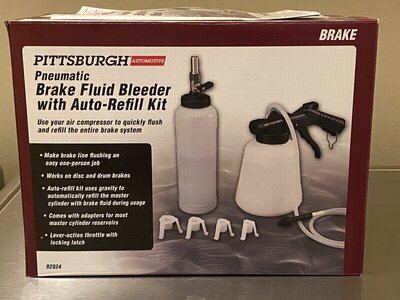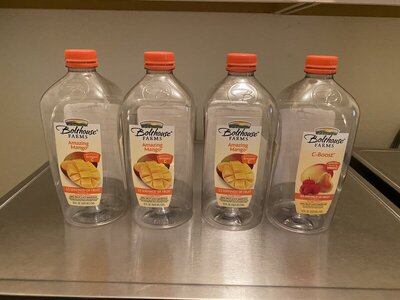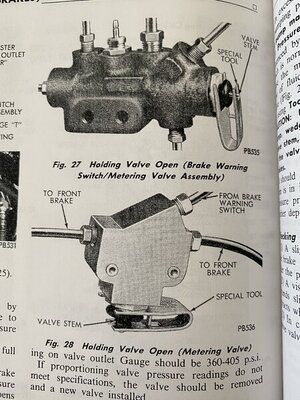MoparGuy68
Well-Known Member
I’ve completed my new disc/drum hydraulic system on my 1971 Super Bee.
Rebuilt: booster, master cylinder (stainless steel sleeved), calipers and wheel cylinders (stainless steel sleeved).
New: OEM 71 brass proportioning valve and metering valve. All OEM hard lines (not stainless steel). OEM hoses. OEM brass tee block.
The entire system is completely dry. I need to fill/bleed it myself, solo, with no help from another person, as I don’t have anyone available to help.
I have a pneumatic bleeder kit, that hooks up to an air compressor, that I got from harbor freight (months ago). My compressor is a 6 gallon pancake with max pressure 150 psi. Bleeder kit says to use with pressure range of 90 to 120 psi.
Don’t know how well the bleeder kit will work with a 6 gallon tank pressurized to only 120 psi.. I know I’ll have to bleed till pressure drops to 90, then run compressor back up to 120, and repeat. Don’t think I’ll be able to use the filler bottle, as it’s designed to mount on a modern reservoir that has a round filler hole with screw on cap.
Do you guys think I should attempt to bleed the master cylinder, via brake pedal, or while off the car first? Or try to bleed the entire system using the compressor, without bleeding the master (in a traditional manner) first?
Lastly, being that the entire system is OEM, I was thinking I should use DOT 3 fluid. The rebuilt master, calipers and wheel cylinders were previously using DOT 3 before the rebuild. They may have been tested with DOT 3, by Karps in CA, before being shipped to me. So, maybe I shouldn’t experiment with using a newer synthetic fluid..

Rebuilt: booster, master cylinder (stainless steel sleeved), calipers and wheel cylinders (stainless steel sleeved).
New: OEM 71 brass proportioning valve and metering valve. All OEM hard lines (not stainless steel). OEM hoses. OEM brass tee block.
The entire system is completely dry. I need to fill/bleed it myself, solo, with no help from another person, as I don’t have anyone available to help.
I have a pneumatic bleeder kit, that hooks up to an air compressor, that I got from harbor freight (months ago). My compressor is a 6 gallon pancake with max pressure 150 psi. Bleeder kit says to use with pressure range of 90 to 120 psi.
Don’t know how well the bleeder kit will work with a 6 gallon tank pressurized to only 120 psi.. I know I’ll have to bleed till pressure drops to 90, then run compressor back up to 120, and repeat. Don’t think I’ll be able to use the filler bottle, as it’s designed to mount on a modern reservoir that has a round filler hole with screw on cap.
Do you guys think I should attempt to bleed the master cylinder, via brake pedal, or while off the car first? Or try to bleed the entire system using the compressor, without bleeding the master (in a traditional manner) first?
Lastly, being that the entire system is OEM, I was thinking I should use DOT 3 fluid. The rebuilt master, calipers and wheel cylinders were previously using DOT 3 before the rebuild. They may have been tested with DOT 3, by Karps in CA, before being shipped to me. So, maybe I shouldn’t experiment with using a newer synthetic fluid..



















